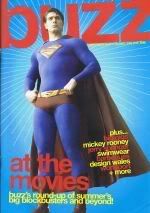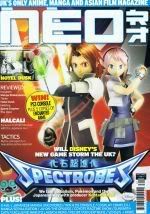Sin City (2005)
Colour is important. Just ask Persil, or the Ku Klux Klan -- or Quentin Tarantino, who was forced to change a scene in Kill Bill Vol. 1 into black and white to save it from being cut entirely. Blood is, apparently, not as disturbing if it's not red -- a view shared by the creators of the classic arcade game House of the Dead, in which exploding zombies are rendered green to make them more child-friendly. Sin City's blood comes in a range of colours: red, yellow, and white. It's predominantly white, though; director Robert Rodriguez uses Frank Miller's original graphic novels as storyboards, and to stunning effect. The film is almost entirely black and white, with only flashes of colour for important, or sometimes just pretty, effect. Blue eyes, red shoes, or Yellow Bastard's horrifically yellow skin are particularly memorable; the latter's improbably sickly, yellow skin somehow communicates all too effectively the repulsive sweat-and-bile stench of his genetically-fucked body.
The Tarantino reference isn't entirely meaningless, either; he guest-directed a scene in Sin City for the princely sum of $1, in return for an earlier favour of Rodriguez's. Both directors are routinely accused of a style over substance approach to filmmaking, though this accusation is not applicable to Sin City. The movie is composed of live actors in front of green screens, enhanced later with computer-generated backgrounds, like last year's Sky Captain and the World of Tomorrow, except that Sky Captain also featured dead actor Laurence Olivier as the villainous Totenkopf. Yeah, and I bet you thought I was just being redundant with that "live actors" line. Shame on you. Anyway, the real difference between the two movies is that while Sky Captain's homage to early 20th century cinema was filled with squeaky clean characters and had a straightforward, ultimately rather 2-dimensional plot, Sin City is infinitely more complex.
In true Tarantino style, the chronology of the movie is decidedly fractured. There are three interlocking stories, spanning nine years, at play: police officer Hartigan (Bruce Willis) rescues an 11 year old Nancy Callahan (Makenzie Vega; later Jessica Alba) from a paedophile's clutches and spends the next nine years in prison as a result; ex-con Marv (Mickey Rourke) sets out to avenge the murder of prostitute Goldie (Jaime King); and murderer Dwight (Clive Owen) endangers the shaky truce of Basin City by killing a well-known hero cop. The "Girls" -- the prostitutes who run Old Town -- and a common enemy, the influential Roark family, are the elements that tie the stories together, though it never quite becomes a wholly coherent narrative.
Sin City is a dark, dangerous world in which men are murderous and women are hookers; surviving another day there is a significant achievement. It's one of those movies that's guaranteed to provoke outrage in the more puritanical among us; it not only trivialises, but glamorises and sexualises violence. Indeed, the Yellow Bastard (Nick Stahl) reportedly can only become aroused at the sound of his victims' tortured screams. There's no sense of morality; Sin City's characters live by their wits -- and their guns, their knives, and their bared midriffs. It's perhaps a worrying reflection on an increasingly desensitised society; movies which were once banned and condemned as "video nasties" -- The Exorcist, A Clockwork Orange, Evil Dead -- now seeming remarkably tame in comparison to the contemporary ultraviolence of movies like Pulp Fiction or Ichi the Killer. However, since I'm not of the Manhunt-banning, shrill media-causes-violence brigade, and it's not my job to "protect" society from these evils, if everyone could just bring their kids up to understand the difference between right and wrong, and fiction and reality, we'd all be a lot happier and I could maybe finish this review without going off on completely irrelevant tangents. The most disturbing scenes in the movie aren't actually gory. The second most disturbing scene features Marv finding his parole officer, Lucille (Carla Gugino) curled naked in his cell with him, following his encounter with Goldie's killer. Rather disappointingly, he's called "Kevin" (Elijah Wood), but since that name strikes terror into the hearts of precisely no-one, I'm going to call him "Freakily Fast Silent Flesh-Eating Killer Boy". Tearfully, Lucille explains the situation: Freakily Fast Silent Flesh-Eating Killer Boy eats people. (I may have inadvertently revealed that a little too early.) Mounted on the wall, game-style, are the heads of various girls who'd gone missing months before; with increasing hysteria, Lucille describes how he'd made her watch as he sucked the meat from her fingers, displaying finally the pitiful stump of what used to be her hand. It's chilling, but the most disturbing scene of the movie is when 19 year old pole dancer Nancy rushes offstage, throwing herself into the arms, and her tongue into the mouth, of a pushing-seventy Hartigan. Bruce Willis or no -- there's wrong, there's wrong, and then there's that.
It's perhaps unfortunate that the violence is the most obvious thing to focus on in Sin City, because it actually has an engrossing plot, some intriguing characters, and quite a sizeable amount of black humour. Dwight's conversations with Jackie Boy's disembodied head are particularly inspired, though the pretentious, wannabe-eloquent hitmen are also a source of endless amusement. Mickey Rourke's return to the silver-screen has dominated a large proportion of Sin City's press coverage, and another unavoidable point about the movie crops up: Sin City is a veritable who's who, who's ever been who, and who ever will be who of Hollywood. Bruce Willis, Mickey Rourke and Clive Owen are key players -- notably, the male characters are far more central to the plot than the female ones, though again this is nothing new; gender stereotypes weren't created by Sin City, and come off it, people, it's called Sin City, you'd think you could've figured out it wasn't all going to be sunshine and kitten heads -- and each give stellar performances, making the roles their own. Despite their comparatively minor roles, Devon Aoki and Nick Stahl (previously of brainwashed ex-grunger Gavin in mostly forgotten, if not ignored entirely early 90s teen horror flick Disturbing Behaviour fame) are equally as impressive; actually, there aren't any weak links here. Even the dialogue presents no cause for complaint.
Setting moral objections to one side -- because it's very hard to care about them -- I can't think of anything about this movie that I didn't enjoy. And for the record, my homicidal tendencies were far more stimulated by The Sweetest Thing than by Sin City -- away with you, Cameron Pizza-Face Diaz!
IMDB link










No comments:
Post a Comment